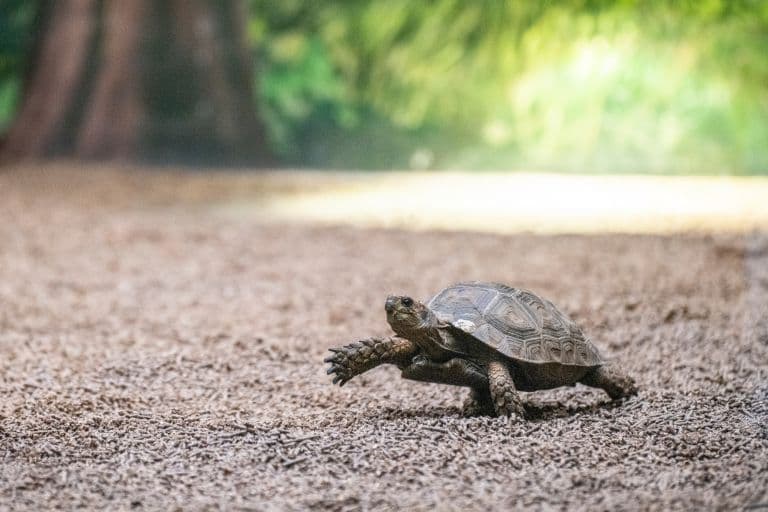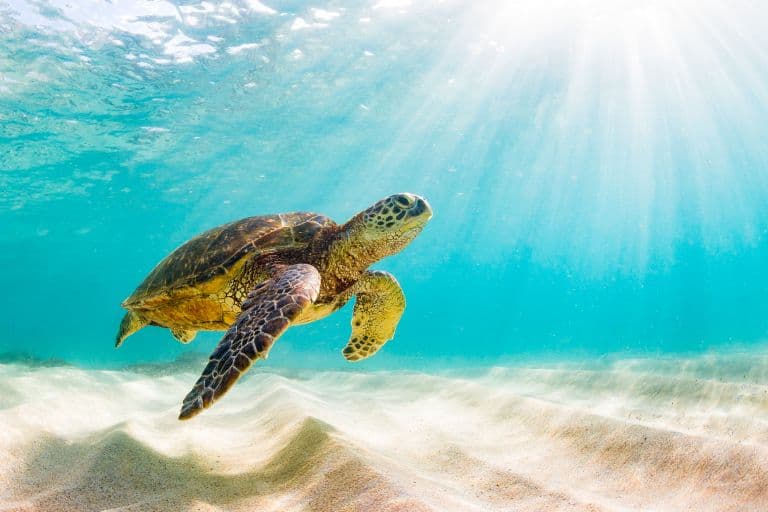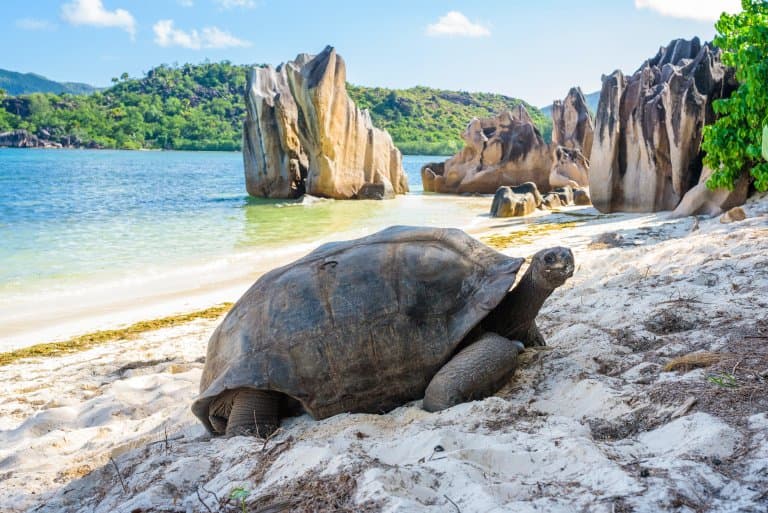Aesop’s legend of the tortoise and the hare is taught all over the English-speaking world. It’s a fable that suggests that being methodical and humble is a more efficient path to success than getting all cocky and blowing your load. Or, something like that.
But in US English, the renowned tortoise is sometimes referred to as a turtle, that animal known to British English speakers to swim long distances and lay eggs on tropical beaches, and is unlikely to ever get into a competition with a European Lagomorph.
In Blade Runner (the good one), Leon asks what a tortoise is, and is told it’s the same thing as a turtle. But tortoises aren’t known to swim, so, something is getting confused here. Why would a turtle be baking in the sun on its back in the desert?
There’s loads of confusion around these two terms, and some of it is simple colloquialism, but some of it is the kind of thing that really riles up the “well actually” crowd, which is great. We’re here to dispel the myths, identify the truths and give you plenty of ammo to make parties a lot less fun.

Here are eight differences between turtles and tortoises.
1. Tortoises are turtles
There you go! End of story (if only it were that simple).
Reptile evolution is a fascinating and convoluted topic.
When fish splatted up into the muddy shallows, they separated into amphibians and those who chose to wrap a film around their eggs so that they can lay them on land.
Of the egg-wrappers, reptiles branched off from mammals, differentiated by the number of holes in the side of their skulls: those with one hole, Synapsids, became mammals and other epic things like Dimetrodons that no longer exist.
Those with no holes and two holes, Anapsids and Diapsids, respectively, became all of the birds and lizards.
Reptiles branched into four orders, one of which was the Testudines, or “turtles”.
Turtles, unlike other reptiles (and birds), don’t have any holes in their skulls, and it was thought that they represent the primitive Anapsid lineage, but recently it’s been discovered that they’re more likely to have evolved from diapsids their holes just fell off when they were no longer useful.
From there, the group splits into two, but this doesn’t make things simpler. The Cryptodira suborder contains the hidden neck turtles (including most sea turtles and tortoises) and the Pleurodira suborder contains a different lineage of side-necked turtles which are freshwater turtles of a totally different branch.
So, this is a roundabout way of saying that all tortoises are Cryptodira turtles. But this isn’t the end of it.

2. Turtles are not tortoises
If your deductive reasoning is strong, this won’t be a shock to you. For example, all dogs are mammals, but not all mammals are dogs. Similarly, all tortoises are turtles, but not all turtles are tortoises.
There is finally a distinction at the family level, and while there are at least 13 families of turtles, only one of them contains the tortoises.
Testudinidae is its name, and all of the species in it are land-based, relatively slow-moving animals known to dominate floppy-eared mammals in long-distance competitions: tortoises.
So, in some contexts there is a distinction between tortoise and turtle, and other times there isn’t. Essentially, tortoises are land turtles.
3. Tortoises are hard
Being lumbering land turtles, they haven’t needed to put a lot of thought into flexibility or agility, and tortoise shells are heavily armoured against bitey predators and hares throwing rocks at them.
Their shells are denser and less flexible than their ocean-going cousins, who are more agile and require more bendy, leathery shells to get by.
But even the heaviest tortoise is nothing compared with the heaviest turtle. A 400kg Galapagos tortoise pales in comparison to the 1-ton, car-sized giant Leatherback! 1
4. Tortoises can’t swim
And this is because leatherbacks can swim.
Drop a tortoise in the ocean and you’ll rightfully be arrested. Half of them are already threatened with extinction, and you’re out here trying to drown what’s left! What were you thinking?
Their clublike feet are useless as paddles even if they don’t sink, and being adapted to a continuous supply of oxygenated gases they won’t be able to hold their breath for long, either.
Honestly, it’s a terrible idea and you should be ashamed of yourself.

5. But they can float
But as it happens, it’s an idea that’s been tried before, by nature at least. Tortoises are terrible swimmers, but they do have buoyancy on their side and can go a long time without eating, so a tortoise blown out to sea in a tropical storm may eventually wash up alive and well in a new kingdom.
In 2004, one was documented doing just that: bobbing along like a coconut until it washed up on the shore, 740km away from its native atoll.
But of course, ocean-going turtles are born to swim. They feed in the water, spending most of their lives in the vast open ocean or resting in a reef, and generally only come onto land to lay eggs. 2
6. Tortoises live for ages
There is a significant difference in the average longevity of tortoise species and that of sea turtles. This is, in part, due to the sparse distribution of tiger sharks on land, but also down to a slower rate of life and a lower metabolism.
Legends are floating around of tortoises who have lived past 320 years, and Johnathan, the oldest tortoise currently alive is pushing two centuries at 191. According to the outstanding dry humour of his long-standing vet, shows no sign of “slowing down”.
This is in contrast with the 70-year lifespan of a green turtle, and the 100-year estimate on other species. 3

7. Australians confuse things
While the British and UK English differ in its use of the word turtle, both use the word tortoise to refer to the land turtle variety in the family Testudinidae.
In Australia, however, there are no native tortoises. There are native turtles, though, and these are often called tortoises in an inexcusable and glaring error on the part of the Australians. So, while the Brits and the Yanks are both right in their own way, the Aussies are way off.
They do make up for this somewhat with outstanding slang such as bin chickens and budgie smugglers. 4
8. There aren’t any in Australasia
There are African and Asian tortoises, North and South American tortoises, Eurasian tortoises, Pacific Island tortoises and even tortoises on remote islands like Madagascar and the Galapagos.
But there are none in Australasia, yet there are many other species of turtle, including iconic sea turtles like leatherbacks, green, loggerheads and hawksbills.
Final Thoughts
So there you have it – turtles versus tortoises!
If you’re not Australian, the difference between a tortoise and a turtle comes down to a simple categorisation argument. In taxonomic ranking, at the order level, there is no distinction; a tortoise is just a turtle that can’t swim. But this specific turtle does have a family of its own and should be recognised as a distinct animal.
The distinction between the umbrella term “turtle” and the more specific “tortoise” is a difference between order and family groupings.
This is the same level of difference between the carnivores and the cats, so while it’s technically correct to say “I’m a carnivore person”, this wouldn’t be much use in figuring out if you relate to dogs more than cats, or indeed, if you were into bears.
Fact Sources & References
- https://oceana.org/marine-life/leatherback-turtle/
- https://www.tandfonline.com/doi/abs/10.1080/00222930601058290
- https://www.smithsonianmag.com/smart-news/the-worlds-oldest-living-land-animal-a-tortoise-named-jonathan-turns-191-180983392/
- https://riversofcarbon.org.au/roc-yass-phase-two/freshwater-turtle-tortoise-australia-busting-common-misconception/
